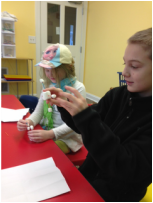|
with Kim Rodgers Molecules and Marshmallows!  This week in Chemistry class we learned about atoms as building blocks for molecules. Atoms must follow rules in order to make a given molecule. For example, hydrogen atoms can only hook to one other atom, while oxygen can’t hook to more than two atoms. We looked at the Lego blocks that the students regularly play with before class and during lunch. We discussed how there are a finite number of other blocks that can attach to any one block. The number of bumps the piece has limits the number of other blocks that can attach. Atoms are the same way. Using toothpicks and two sizes of marshmallows, the students made as many creations as they could. After a while of creating they drew pictures of their favorite ones. We then placed a rule on our creations. Each large marshmallow can only have three toothpicks coming off of it. The students could still create many different structures. We then moved to two toothpicks per large marshmallow, finally moving to only one toothpick. Afterwards we discussed how each time we put a constriction on how the structures could be assembled, our possibilities for creating were constricted as well. This drove the point home that each atom having a certain amount of bonds allows certain molecules to be formed. There is order instead of chaos. We followed up this activity by observing how molecules move in cold and hot water, as opposed to room temperature water, which we observed last week. The students helped put together our experiment making sure the variables were all equal to make the experiment true. Ahead of time I had put ice in one bowl of water and heated another bowl of water. We put one cup of cold water in one cup and one cup of warm water in another. We put yellow food coloring in two droppers and blue food coloring in two others. On the count of three one drop of yellow and one drop of blue were dropped into each cup. The students observed that the colors mixed much more quickly in the hot water than the cold. We concluded that the molecules in the hot water must move more quickly as well. We drew pictures of each cup showing the mixing of the colors, along with a drawing depicting the movement of the molecules in each temperature of water. Embroidery and the Battle of Hastings In the Middle Ages class we read about the Battle of Hastings when Harold and William were vying for the throne of England. Harold was a nobleman from Wessex, where Alfred the Great had come from, and William was from across the English Channel in Normandy where he had married an English princess. Edward the Conqueror, the actual king of England, was growing old and had no sons to inherit the crown. Before Edward died Harold was sailing along the coast of Wessex and got caught up in a storm which landed him and his ship on the coast of Normandy. William quickly invited him up to his castle and had a huge feast. Harold was wary. At the end of the feast William made Harold swear to give William the throne by laying his hands flat on the table in front of him. Seeing as Harold really had no choice, he swore the oath. William pulled away the tablecloth for Harold to find that he had sworn the oath on a box of old saint’s bones, sort of like our modern day version of swearing on the Bible! When Edward the Confessor died several years later Harold did not end up keeping that oath, which led to the Battle of Hastings. This battle is depicted in the Bayeaux Tapestry, which is an amazing embroidered account of the battle that extends 17 meters and was created a few years after the battle took place! The students and I watched a short video about it. We also watched a short video on the five most used embroidery stitches. They used a clean piece of paper to map out what they would like to embroider. Once they finished that they transferred the picture to the embroidery cloth using very thin Sharpies. Then the embroidering began. They were all very focused on what they were doing. I was the one who was slowing them down when they needed a new color of thread. They were patient with me. The plan is to continue working on these as we move through our class time together over the next several weeks. HomeworkHomework for both classes remains the same: a notebooking page for each class, plus
finishing up the mapping page for History. Have a great week! Comments are closed.
|
Categories
All
Archives
May 2016
|









 RSS Feed
RSS Feed